REFRACTION
Refraction is passing of light from one optical medium to another optical medium through a boundary. In refraction, the angle of incidence i in one medium and the angle of refraction r in the other medium are measured with respect to the normal drawn to the surface at the point of incidence of light. According to laws of refraction, (i) The incident ray, refracted ray and
normal to the refracting surface are all coplanar (ie. lie in the same plane).
(ii) The ratio of sine of angle of incident i in the first medium to the sine of angle of refraction r in the second medium is equal to the ratio of refractive index \(n_{2} \) of the second medium to the refractive index \(n_{1} \) of the first medium.
\(\frac{\sin i}{\sin r}=\frac{n_{2}}{n_{1}}\)The above equation is in the ratio form. It can also be written in a product form as,
\(n_{1} \sin i=n_{2} \sin r\)The law of refraction is also known as Snell’s law.
The refraction at a boundary is shown in Figure 6.15.
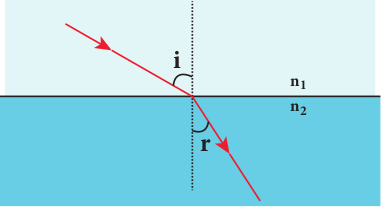
For normal incidence of light on a surface, the angle of incidence is zero.

Angle of deviation due to refraction
The angle between the direction of incident ray and the refracted ray is called angle of deviation due to refraction. When light travels from rarer to denser medium, it deviates towards normal as shown in Figure 6.16. The angle of deviation in this case is,
\(d=i-r\)
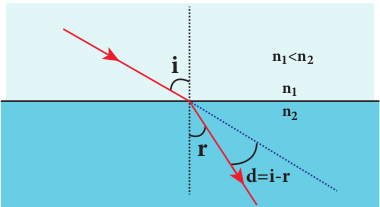
On the other hand, if light travels from denser to rarer medium, it deviates away from normal as shown in Figure 6.17. The angle of deviation in this case is,
\(d=r-i\)
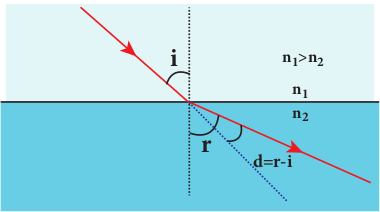
simultaneous reflection (or) refraction
In any refracting surface there will also be some reflection taking place. Thus, the intensity of refracted light will be lesser than the incident light. The phenomenon in which a part of light from a source undergoing reflection and the other part of light from the same source undergoing refraction at the same surface is called _simultaneous reflection (_or) simultaneous refraction. This is shown in Figure 6.18. Such surfaces are available as partially silvered glasses.
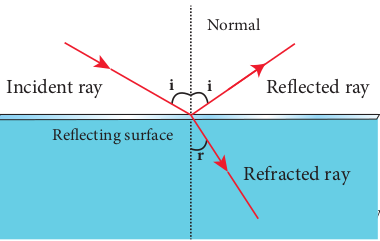
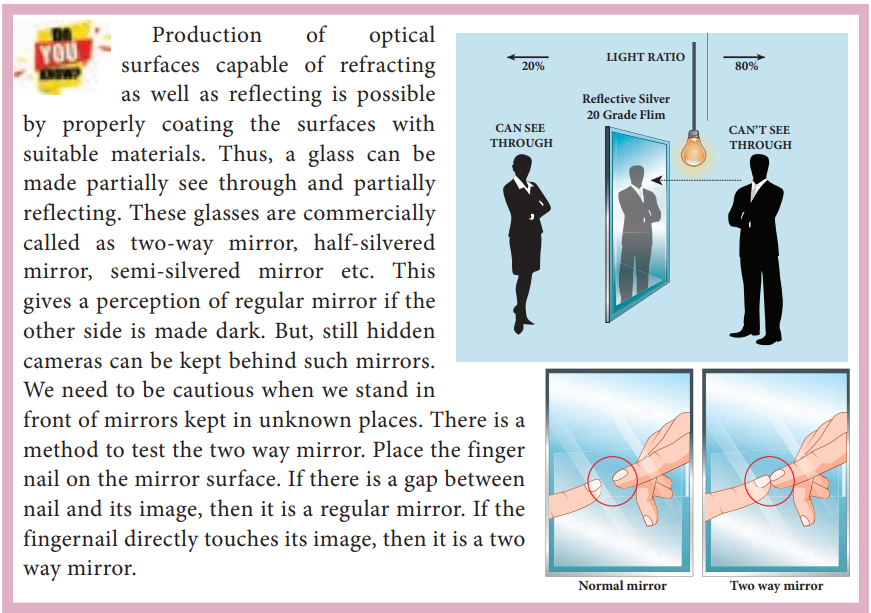
Principle of reversibility
The principle of reversibility states that light will follow exactly the same path if its direction of travel is reversed. This is true for both reflection and refraction as shown in Figure 6.19.

Relative refractive index
In equation (6.18), the term \(\left(\frac{n_{2}}{n_{1}}\right)\) is called relative refractive index of second medium with respect to the first medium which is denoted as \(n_{21}\) .
\(n_{21}=\frac{n_{2}}{n_{1}}\)The concept of relative refractive index gives rise to other useful relations such as,
(i) Inverse rule:
\(n_{12}=\frac{1}{n_{21}} \text { (or) } \frac{n_{1}}{n_{2}}=\frac{1}{n_{2} / n_{1}}\)(ii) Chain rule:
\(n_{32}=n_{31} \times n_{12} \text { (or) } \frac{n_{3}}{n_{2}}=\frac{n_{3}}{n_{1}} \times \frac{n_{1}}{n_{2}}\)EXAMPLE 6.7
Light travelling through transparent oil enters in to glass of refractive index 1.5. If the refractive index of glass with respect to the oil is 1.25, what is the refractive index of the oil?
Solution
Given, \(n_{g o}=1.25\) and \(n_{g}=1.5\)
Refractive index of glass with respect to oil,
\(n_{g o}=\frac{n_{g}}{n_{o}}\)Rewriting for refractive index of oil,
\(n_{o}=\frac{n_{g}}{n_{g o}}=\frac{1.5}{1.25}=1.2\)The refractive index of oil is, \(n_{o}=1.2\)
Apparent depth
It is a common observation that the bottom of a tank filled with water appears to be raised when seen from air medium above as shown in Figure 6.19(a). An equation could be derived for the apparent depth when viewed in the near normal direction.
Light from the object $O$ at the bottom of the tank passes from denser medium (water) to rarer medium (air) to reach our eyes for viewing the object as shown in Figure 6.20 (b). It deviates away from the normal in the rarer medium at the point of incidence $B$ as shown in Figure 6.20 (c). The refractive index of the denser medium is \(n_{1}\) and that of rarer medium is \(n_{2}\) . Here, \(n_{1}>n_{2}\) . The angle of incidence in the denser medium is i and the angle of refraction in the rarer medium is r. The lines \(N N^{\prime}\) and O D are parallel. Thus, the angle \(\angle D I B\) is also r. The angles i and r are very small as the diverging light from O entering the eye is very narrow. The Snell’s law in product form for this refraction from equation (6.19) is,
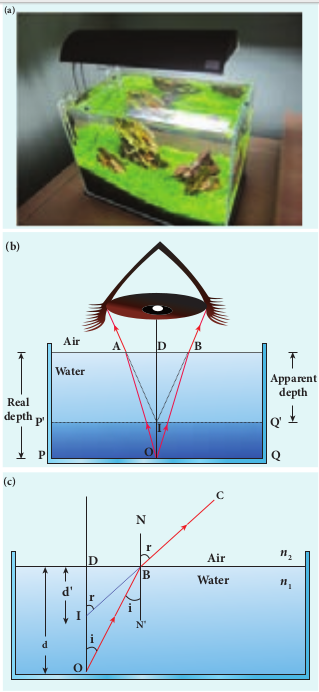
Figure 6.20 Apparent depth
\(n_{1} \sin i=n_{2} \sin r\)As the angles i and r are small, we can approximate, \(\sin i \approx \tan i\) and \(\sin r \approx \tan r\) .
\(n_{1} \tan i=n_{2} \tan r\)In triangles \(\triangle D O B\) and \(\triangle D I B\) ,
\(\tan i=\frac{D B}{D O}\) and \(\tan r=\frac{D B}{D I}\) \(n_{1} \frac{D B}{D O}=n_{2} \frac{D B}{D I}\)
D B is cancelled both sides. Now, D O is the actual depth d and D I is the apparent depth \(d^{\prime}\) .
\(n_{1} \frac{1}{d}=n_{2} \frac{1}{d^{\prime}} \quad \text { After rearranging, }\) \(\frac{d^{\prime}}{d}=\frac{n_{2}}{n_{1}}\)Rewriting the above equation for the apparent depth \(d^{\prime}\) ,
\(d^{\prime}=\frac{n_{2}}{n_{1}} d\)As the rarer medium is air, its refractive index \(n_{2}\) can be taken as \(1,\left(n_{2}=1\right)\) . And the refractive index \(n_{1}\) of denser medium could then be taken as n itself, \(\left(n_{1}=n\right)\) . Now, the equation for apparent depth becomes,
\(d^{\prime}=\frac{d}{n}\)The bottom appears to be elevated by \(d-d^{\prime}\) ,
\(\begin{aligned} & d-d^{\prime}=d-\frac{d}{n} \text { or } \\ & d-d^{\prime}=d\left(1-\frac{1}{n}\right) \end{aligned}\) layers of atmosphere which vary in refractive index, the path of light deviates continuously when it passes through the atmosphere. For example, the Sun is visible a little before the actual sunrise and also until a little after the actual sunset due to refraction of light through the atmosphere. What we mean by actual sunrise is the actual crossing of the sun at the horizon. Figure shows the actual and apparent positions of the sun with respect to the horizon. The figure is highly exaggerated to show the effect. The apparent shift in the direction of the sun is around half a degree and the corresponding time difference between the actual and apparent positions is about 2 minutes. Sun appears flattened (oval shaped) during sun rise and sunset due to the same phenomenon.
The same is also applicable for the positions of stars as shown in Figure. Actually, the stars do not twinkle. They appear twinkling because of the movement of the atmospheric layers with varying refractive indices which is clearly seen in the night sky.

EXAMPLE 6.8
A coin is at the bottom of a trough containing three immiscible liquids of refractive indices 1.3, 1.4 and 1.5 poured one above the other of heights 30 cm, 16 cm, and 20 cm respectively. What is the apparent depth at which the coin appears to be when seen from air medium outside? In which medium the coin will appear?
Solution When seen from (air medium) on top, the coin will still appear to be at the bottom with each medium appearing to have shrunk with respect to the air medium outside. This situation is illustrated below.
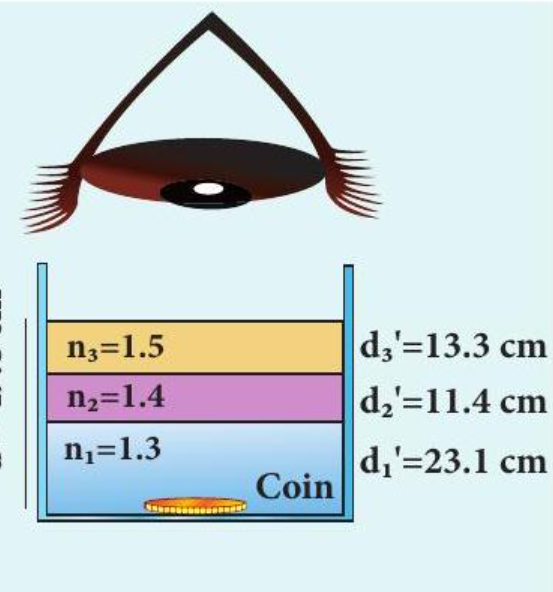
The equations for apparent depth for each medium is,
\(d_{1}^{\prime}=\frac{d_{1}}{n_{1}} ; \quad d_{2}^{\prime}=\frac{d_{2}}{n_{2}} ; \quad d_{3}^{\prime}=\frac{d_{3}}{n_{3}}\) \(d^{\prime}=d_{1}^{\prime}+d_{2}^{\prime}+d_{3}^{\prime}=\frac{d_{1}}{n_{1}}+\frac{d_{2}}{n_{2}}+\frac{d_{3}}{n_{3}}\) \(d^{\prime}=\frac{30}{1.3}+\frac{16}{1.4}+\frac{20}{1.5}=23.1+11.4+13.3\) \(d^{\prime}=47.8 \mathrm{~cm}\)Critical angle and total internal reflection
When a ray passes from an optically denser medium to an optically rarer medium, it bends away from the normal. Because of this, the angle of refraction r in the rarer medium is greater than the corresponding angle of incidence i in
the denser medium. As angle of incidence i is gradually increased, r rapidly increases and at a certain stage r becomes 90° and the refracted ray will be gracing the boundary. The angle of incidence in the denser medium for which the angle of refraction is 90° (or) the refracted ray graces the boundary between the two media is called critical angle ic.
If the angle of incidence in the denser medium is increased beyond the critical angle, there is no refraction possible in to the rarer medium. For any angle of incidence greater than the critical angle, the entire light is reflected back into the denser medium itself. This phenomenon is called total internal reflection. These are shown in Figure 6.21.
The two conditions for total internal reflection to take place are, (i) light must travel from denser to rarer
medium, (ii) angle of incidence in the denser medium
must be greater than critical angle (i>ic).
For critical angle of incidence, the Snell’s law in the product form, equation (6.19) becomes,
\(\begin{aligned} & n_{1} \sin i_{c}=n_{2} \sin 90^{\circ} \\ & n_{1} \sin i_{c}=n_{2} \quad \because \sin 90^{\circ}=1 \\ & \sin i_{c}=\frac{n_{2}}{n_{1}} \end{aligned}\)Here, \(n_{1}>n_{2}\)
If the rarer medium is air, then its refractive index \(n_{2}\) is \(1,\left(n_{2}=1\right)\) and the refractive index of the denser medium \(n_{1}\) is taken as n itself, \(\left(n_{1}=n\right)\) then,
\(\sin i_{c}=\frac{1}{n} \text { (or) } i_{c}=\sin ^{-1}\left(\frac{1}{n}\right)\)The critical angle \(i_{c}\) depends on the refractive index n of the medium. Table 6.3 shows the refractive index and the critical angle for different materials.
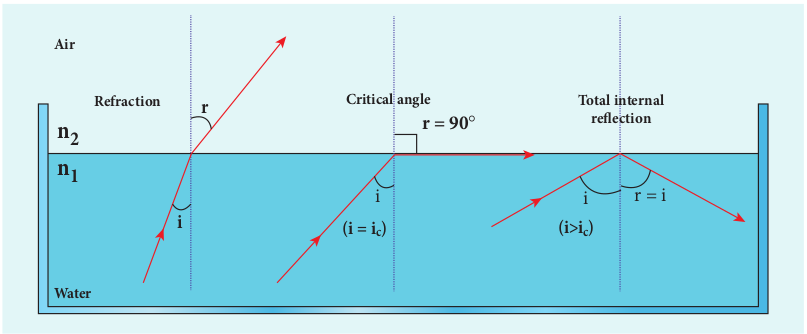
Table 6.3 Refractive index and critical angle for different media
| Material | Refractive index | Critical Angle |
|---|---|---|
| Ice | 1.310 | 49.8° |
| Water | 1.333 | 48.6° |
| Fused Quartz | 1.458 | 43.3° |
| Crown Glass | 1.541 | 40.5° |
| Flint Glass | 1.890 | 31.9° |
| Calcite | 1.658 | 37.0° |
| Strontium Titanate | 2.394 | 24.7° |
| Diamond | 2.417 | 24.4° |
| Rutile | 2.621 | 22.4° |
For example the refractive index of glass is about 1.5. The critical angle for glass-air interface is, \(i_{c}=\sin ^{-1}\left(\frac{1}{1.5}\right)=41.8^{\circ}\) . The refractive index of water is 1.33 . The critical angle for water-air interface is, \(i_{c}=\sin ^{-1}\left(\frac{1}{1.3}\right)=48.6^{\circ}\) .
Effects due to total internal reflection
6.4.7.1 Glittering of diamond Diamond appears dazzling because of
the total internal reflection of light that happens inside the diamond. The refractive index of diamond is about 2.417. It is much greater than the refractive index of ordinary glass which is about only 1.5. The critical angle of diamond is about 24.4°. It is much less than that of ordinary glass. A skilled diamond cutter makes use of this larger range of angle of incidence (24.4° to 90° inside the diamond), to ensure that light entering the diamond is total internally reflected from the many cut faces before getting out as shown in Figure 6.22. This gives a sparkling effect for diamond.
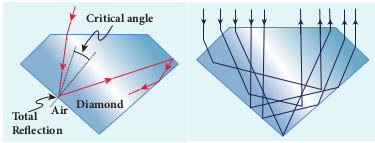
Figure 6.22 Total internal reflection in diamond.
6.4.7.2 Mirage and looming The refractive index of air increases with its density. In hot places, air near the ground is hotter than air at a height. Hot air is less dense. Hence, in still air the refractive index of air increases with height. Because of this, the light from tall objects like a tree, try to pass through a medium whose refractive index decreases towards the ground. Hence, the ray of light successively deviates away from the normal at different layers of air and undergoes total internal reflection when the angle of incidence near the ground exceeds the critical angle. This gives an illusion as if the light comes from somewhere below the ground. Because of the shaky nature of the layers of air, the observer feels as if
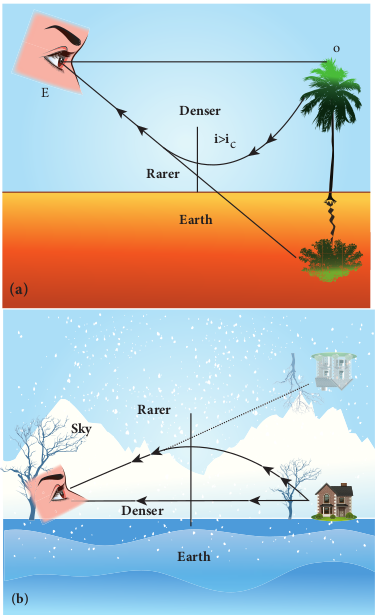
Figure 6.23 (a) Mirage and (b) looming the object is getting reflected by a pool of water (or) wet surface beneath the object as shown in Figure 6.23(a). This phenomenon is called mirage.
In the cold places the refractive index increases towards the ground because the temperature of air close to the ground is lesser than the temperature at a height above the surface of earth. Thus, the density and refractive index of air close to the ground is greater than for air at a height. In the cold regions like glaciers and frozen lakes, the reverse effect of mirage will happen. Hence, an inverted image is formed little above the surface as shown in Figure 6.23(b). This phenomenon is called looming. It is also called as superior mirage, towering and stooping.
** Prisms making using of total internal reflection**
Prisms can be designed to reflect light by \(90^{\circ}\) (or) by \(180^{\circ}\) by making use of total internal reflection as shown in Figure 6.24(a) and 6.24(b).
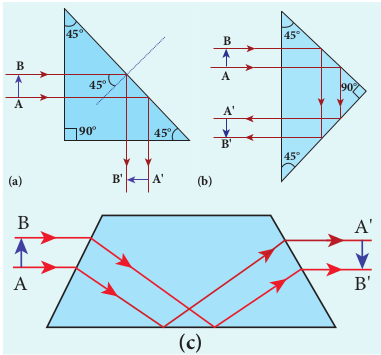
In the first two cases, the critical angle ic for the material of the prism must be less than 45o. Prism in Figure 6.24(b) inverts the object on the same side. Prism in Figure 6.24(c) inverts the object on the other side.
6.4.7.4 Radius of illumination (Snell’s window)
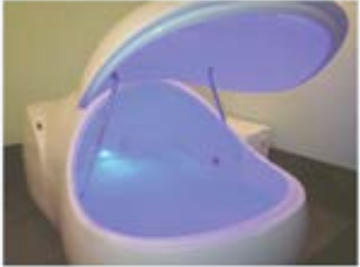
When a source of light like electric bulb is kept inside a water tank, the light from the source travels in all direction inside the water. The light that is incident on the water surface at an angle less than the critical angle will undergo refraction and emerge out from the water. The light incident at an angle greater than critical angle will undergo total internal reflection.The light falling particularly at critical angle graces the surface. Thus, the entire surface of water appears illuminated when seen from outside as shown in Figure 6.25.
On the other hand, when the light entering the water from outside is seen from inside the water, the view is restricted to a particular angle equal to the critical angle ic. The restricted illuminated circular area is called Snell’s window as shown in Figure 6.26(a).The Figure 6.26(b) shows the angle of view for water animals.
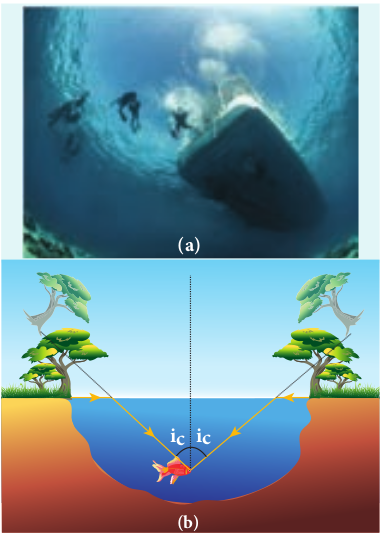
The angle of view for water animals is restricted to twice the critical angle 2_ic_. The critical angle for water is 48.6o. Thus the angle of view is 97.2o. The radius R of the circular area depends on the depth d from which it is seen and also the refractive index n of the medium. The radius R of Snell’s window can be deduced with the illustration as shown in Figure 6.27.
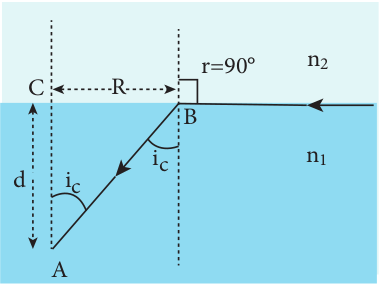
Light is seen from a point A at a depth d. The Snell’s law in product form, equation (6.19), for the refraction happening at the point B on the boundary between the two media is,
\(n_{1} \sin i_{c}=n_{2} \sin 90^{\circ}\) \(n_{1} \sin i_{c}=n_{2} \quad \because \sin 90^{\circ}=1\) \(\sin i_{c}=\frac{n_{2}}{n_{1}}\)From the right angle triangle \(\triangle \mathrm{ABC}\) ,
\(\sin i_{c}=\frac{C B}{A B}=\frac{R}{\sqrt{d^{2}+R^{2}}}\)Equating the above two equations (6.33) and (6.34), \(\frac{R}{\sqrt{d^{2}+R^{2}}}=\frac{n_{2}}{n_{1}}\)
Squaring on both sides, \(\frac{R^{2}}{R^{2}+d^{2}}=\left(\frac{n_{2}}{n_{1}}\right)^{2}\)
Taking reciprocal, \(\frac{R^{2}+d^{2}}{R^{2}}=\left(\frac{n_{1}}{n_{2}}\right)^{2}\)
Further simplifying,
\(\begin{aligned} & 1+\frac{d^{2}}{R^{2}}=\left(\frac{n_{1}}{n_{2}}\right)^{2} ; \quad \frac{d^{2}}{R^{2}}=\left(\frac{n_{1}}{n_{2}}\right)^{2}-1 ; \\ & \frac{d^{2}}{R^{2}}=\frac{n_{1}^{2}}{n_{2}^{2}}-1=\frac{n_{1}^{2}-n_{2}^{2}}{n_{2}^{2}} \end{aligned}\)Again taking reciprocal and rearranging, \(\frac{R^{2}}{d^{2}}=\frac{n_{2}^{2}}{n_{1}^{2}-n_{2}^{2}} ; \quad R^{2}=d^{2}\left(\frac{n_{2}^{2}}{n_{1}^{2}-n_{2}^{2}}\right)\)
After taking the squre root, the radius of illumination is,
\(R=d \sqrt{\frac{n_{2}^{2}}{\left(n_{1}^{2}-n_{2}^{2}\right)}}\)If the rarer medium outside is air, then, \(n_{2}=1\) and we can take \(n_{1}=n\)
\(R=d\left(\frac{1}{\sqrt{n^{2}-1}}\right) \text { (or) } R=\frac{d}{\sqrt{n^{2}-1}}\)EXAMPLE 6.9
What is the radius of the illumination when seen above from inside a swimming pool from a depth of 10 m on a sunny day? What is the total angle of view? [Given, refractive index of water is 4/3]
Solution Given, \(n=4 / 3, d=10 \mathrm{~m}\) .
Radius of illumination, \(R=\frac{d}{\sqrt{n^{2}-1}}\)
\(R=\frac{10}{\sqrt{(4 / 3)^{2}-1}}=\frac{10 \times 3}{\sqrt{16-9}}\) \(R=\frac{30}{\sqrt{7}}=11.32 \mathrm{~m}\)To find the critical angle,
\(i_{c}=\sin ^{-1}\left(\frac{1}{n}\right)\) \(i_{c}=\sin ^{-1}\left(\frac{1}{4 / 3}\right)=\sin ^{-1}\left(\frac{3}{4}\right)=48.6^{\circ}\)The total angle of view of the cone is,
\(2 i_{c}=2 \times 48.6^{\circ}=97.2^{\circ}\)6.4.7.5 Optical fibre Transmitting the signals through optical
fibres is possible due to the phenomenon of total internal reflection. Optical fibres consist of inner part called core and outer part called cladding (or) sleeving. The refractive index of the core must be higher than that of the cladding for total internal reflection to happen. Signal in the form of light is made to incident inside the core- cladding boundary at an angle greater than

the critical angle. Hence, it advances with repeated total internal reflections inside the optical fibre without undergoing any refraction. The light travels inside the core with no appreciable loss in the intensity of the light as shown in Figure 6.28(a). While bending the optical fibre, it is done in such a way that the condition for total internal reflection is ensured at every reflection inside the fibre as shown in Figure 6.28(b).
6.4.7.6 Acceptance angle in optical fibre To ensure the critical angle incidence
in the core-cladding boundary inside the optical fibre, the light should be incident at a certain angle called acceptance angle at the end of the optical fibre while entering into it. It depends on the refractive indices of the core _n_1, cladding _n_2 and the outer medium _n_3. Assume that the light is incident at an angle called acceptance angle ia at the outer medium-core boundary at A as shown in Figure 6.29(a).
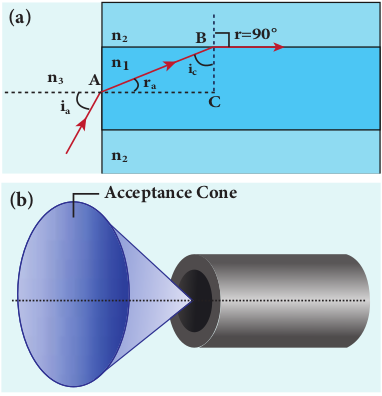

The Snell’s law in the product form, equation (6.19), for this refraction at the point A is,
\(n_{3} \sin i_{a}=n_{1} \sin r_{a}\)To have the total internal reflection inside the optical fibre, the angle of incidence at the core-cladding interface at B should be atleast critical angle \(i_{c}\) . Snell’s law in the product form, equation (6.19), for the refraction at point B is,
\(n_{1} \sin i_{c}=n_{2} \sin 90^{\circ}\) \(n_{1} \sin i_{c}=n_{2} \quad \because \sin 90^{\circ}=1\) \(\therefore \sin i_{c}=\frac{n_{2}}{n_{1}}\)From the right angle triangle \(\triangle A B C\) ,
\(i_{c}=90^{\circ}-r_{a}\)Now, equation (6.39) becomes, \(\sin \left(90^{\circ}-r_{a}\right)=\frac{n_{2}}{n_{1}}\) (or) \(\cos r_{a}=\frac{n_{2}}{n_{1}}\)
\(\sin r_{a}=\sqrt{1-\cos ^{2} r_{a}}\)Substituting for \(\cos r_{a}\)
\(\sin r_{a}=\sqrt{1-\left(\frac{n_{2}}{n_{1}}\right)^{2}}=\sqrt{\frac{n_{1}^{2}-n_{2}^{2}}{n_{1}^{2}}}\)Substituting this in equation (6.37).
\(\mathrm{n}_{3} \sin i_{a}=n_{1} \sqrt{\frac{n_{1}^{2}-n_{2}^{2}}{n_{1}^{2}}}=\sqrt{n_{1}^{2}-n_{2}^{2}}\)On further simplification,
\(\begin{aligned} & \sin i_{a}=\frac{\sqrt{n_{1}^{2}-n_{2}^{2}}}{n_{3}} \text { (or) } \sin i_{a}=\sqrt{\frac{n_{1}^{2}-n_{2}^{2}}{n_{3}^{2}}} \\ & i_{a}=\sin ^{-1}\left(\sqrt{\frac{n_{1}^{2}-n_{2}^{2}}{n_{3}^{2}}}\right) \end{aligned}\)If outer medium is air, then \(n_{3}=1\) . The acceptance angle \(i_{a}\) becomes,
\(i_{a}=\sin ^{-1}\left(\sqrt{n_{1}^{2}-n_{2}^{2}}\right)\)Light can have any angle of incidence from 0 to \(i_{a}\) with the normal at the end of the optical fibre forming a conical shape called acceptance cone as shown in Figure 6.29(b). In the equation (6.42), the term \(\left(n_{3} \sin i_{a}\right)\) is called numerical aperture NA of the optical fibre.
\(N A=n_{3} \sin i_{a}=\sqrt{n_{1}^{2}-n_{2}^{2}}\)If outer medium is air, then \(n_{3}=1\) . The numerical aperture NA becomes,
\(N A=\sin i_{a}=\sqrt{n_{1}^{2}-n_{2}^{2}}\)EXAMPLE 6.10
A optical fibre is made up of a core material with refractive index 1.68 and a cladding material of refractive index 1.44. What is the acceptance angle of the fibre if it is kept in air medium without any cladding?
Solution Given, \(n_{1}=1.68, \quad n_{2}=1.44, \quad n_{3}=1\)
Acceptance angle, \(i_{a}=\sin ^{-1}\left(\sqrt{n_{1}^{2}-n_{2}^{2}}\right)\)
\(i_{a}=\sin ^{-1}\left(\sqrt{(1.68)^{2}-(1.44)^{2}}\right)=\sin ^{-1}(0.865)\) \(i_{a} \approx 60^{\circ}\)If there is no cladding then, \(n_{2}=1\)
Acceptance angle, \(i_{a}=\sin ^{-1}\left(\sqrt{n_{1}^{2}-1}\right)\)
\(i_{a}=\sin ^{-1}\left(\sqrt{(1.68)^{2}-1}\right)=\sin ^{-1}(1.35)\)\(\sin ^{-1}( more than 1)\) is not possible. But, this includes the range \(0^{\circ}\) to \(90^{\circ}\) . Hence, all the rays entering the core from flat surface will undergo total internal reflection.
Note: If there is no cladding then there is a condition on the refractive index \(\left(n_{1}\right)\) of the core.
\(i_{a}=\sin ^{-1}\left(\sqrt{n_{1}^{2}-1}\right)\)Here, as per mathematical rule, \(\left(n_{1}^{2}-1\right) \leq 1 \quad\) or \(\quad\left(n_{1}^{2}\right) \leq 2\)
\(\text { or } \quad n_{1} \leq \sqrt{2}\)Hence, in air (no cladding) the refractive index \(n_{1}\) of the core should be, \(n_{1} \leq 1.414\)
Do you know ?
An endoscope which has a bundle of optical fibres is an instrument used by doctors to see
inside of a patient’s body. Endoscopes work on the phenomenon of total internal reflection. The optical fibres are inserted into the body through mouth, nose (or) a special hole made in the body. Even operations could be carried out with the endoscope cables which have the necessary instruments attached at their ends.
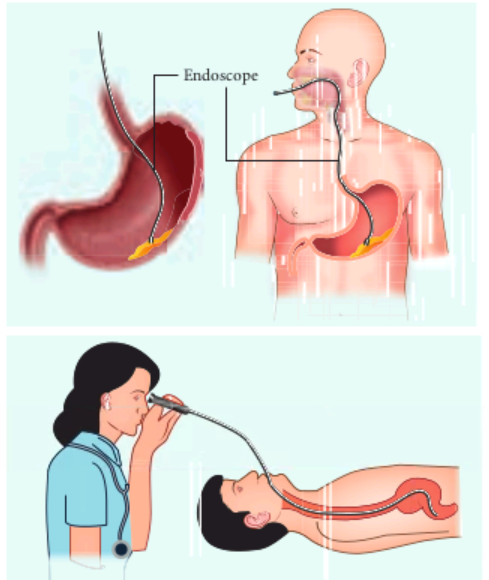
Refraction in glass slab
When a ray of light enters a slab it travels from rarer medium (air) to denser medium (glass). This results in deviation of the ray towards the normal. When the light ray leaves the slab it travels from denser medium (glass) to rarer medium (air) resulting in deviation of the ray away from the normal. After the two refractions,
the light ray emerges in the same direction as that of the incident ray on the glass slab with a lateral displacement (or) shift L. i.e. There is no change in the direction of the ray but, the path of the incident ray and refracted ray are parallel to each other with a shift L, as shown in Figure 6.30.

Figure 6.30 Refraction in glass slab
Consider a glass slab of thickness t and refractive index n kept in air medium. If the path of the light is A B C D, the refractions occur at two points B and C in the glass slab. The angles of incidence i and refraction r are measured with respect to the normal \(N_{1}\) and \(N_{2}\) at the two points B and C respectively. The lateral displacement L is the perpendicular distance C E drawn between the paths of the deviated light and the undeviated light at point C.
In the right angle triangle \(\triangle B C E\) ,
\(\sin (i-r)=\frac{L}{B C} ; \quad B C=\frac{L}{\sin (i-r)}\)In the right angle triangle \(\triangle B C F\) ,
\(\cos (r)=\frac{t}{B C} ; \quad B C=\frac{t}{\cos (r)}\)Equating equations (6.48) and (6.49),
\(\frac{L}{\sin (i-r)}=\frac{t}{\cos (r)}\)After rearranging,
\(L=t\left(\frac{\sin (i-r)}{\cos (r)}\right)\)The lateral displacement depends upon (i) the thickness of the slab, (ii) the angle of incidence and (iii) the refractive index of the slab which decides the angel of refraction. Thicker the slab, larger will be the lateral displacement. Greater the angle of incidence, larger will be the lateral displacement. Higher the refractive index, larger will be the lateral displacement.
EXAMPLE 6.11
The thickness of a glass slab is \(0.25 \mathrm{~m}\) . It has a refractive index of 1.5. A ray of light is incident on the surface of the slab at an angle of \(60^{\circ}\) . Find the lateral displacement of the light when it emerges from the other side of the glass slab.
Solution Given, thickness of the slab, \(t=0.25 \mathrm{~m}\) , refractive index, \(n=1.5\) , angle of incidence, \(i=60^{\circ}\) .
Using Snell’s law, \(1 \sin i=n \sin r\)
\(\sin r=\frac{\sin \mathrm{i}}{n}=\frac{\sin 60^{\circ}}{1.5}=0.58\) \(r=\sin ^{-1}(0.58)=35.25^{\circ}=35^{\circ} 15^{\prime} 0^{\prime \prime}\)Lateral displacement is, \(L=t\left(\frac{\sin (i-r)}{\cos (r)}\right)\)
\(L=(0.25) \times\left(\frac{\sin (60-35.25)}{\cos (35.25)}\right)=0.1281 \mathrm{~m}\)The lateral displacement is, \(L=12.81 \mathrm{~cm}\)